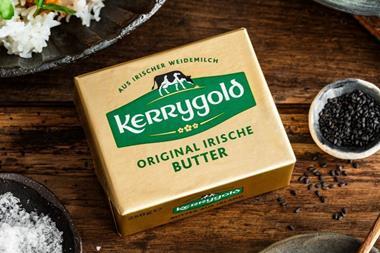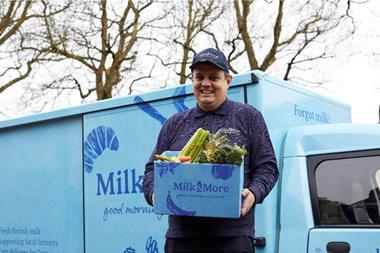The merger of the New Zealand Dairy Board's EU dairy products business into Arla Foods is still subject to regulatory approval. But now the dust has settled on the initial announcement, many industry insiders think the move is a sensible one in the context of a yellow fats market in decline.
The merger will give new organisation Arla Foods Fonterra a 15.6% share of the UK yellow fats market, but Unilever Bestfoods is at 32% and logic dictates it will stay a strong number one.
But if Unilever Bestfoods is unlikely to be too worried, it must still be remembered that Arla and Anchor are two of the biggest spenders in the butter category, with Lactalis the third, and are set for a lively programme of NPD and value adding.
UB has admitted that Arla has "lofty ambitions" and that before it launched Flora Pro-activ, Lurpak was closing the gap on the Flora brand.
Tony Lucas, marketing director of St Ivel, manufacturer of Utterly Butterly spreads, said the outcome of the Anchor-Lurpak union would depend on the brand strategy adopted.
However, until the partnership between NZ Milk and Arla has been cleared, it's business as usual according to NZ Milk. "There's a brand at the heart of this and we cannot let it be damaged in the interim," says marketing director Jaspal Chada.
"Our core strategy was to get behind Anchor Spreadable and accelerate growth, and the figures for September are good.
"We've resecured market leadership with a 30% volume share for Spreadable compared with Lurpak Spreadable at 26.9%. In value terms we had 24.5% and Lurpak had 35%. Lurpak now has 33.5% and we have 27.7%, so the gap is closing. Now we are waiting for repeat purchase. It's crunch time."
NZ Milk claims the rate of decline has also slowed on Anchor block butter thanks to consumers' increased awareness about what they eat. Chada says: "The words free range' on pack are working and making consumers think."
The same wording will shortly be carried on Anchor Spreadable packs.
Arla also professes success with its hard hitting marketing. In its centenary year it claims Lurpak is now worth more than £107m and is growing 5% year- on-year.
Brand manager Danny Micklethwaite says: "Taste is top in motivating consumers and we've invested a lot in getting the taste right for our new Lurpak Lighter Spreadable. A lot of products may be healthier or lower in fat, but they don't deliver in taste."
Arla invested heavily in Lurpak Lighter Spreadable which took almost three years to develop and contains 25% less fat than standard butter.
The product is also heavily backed by above-the-line activity which Arla says will go a long way towards its main objective of long-term brand building.
Arla is also focused on the fact that block butter is in decline and is working on plans to turn around the performance of Lurpak Classic.
The success of spreadable butters, low fat and functional spreads has made the industry sit up and reassess the fixture. Merchandising is a major issue, with all sides of the arena having differing views on labelling and the best use of shelf space.
UB invests about £20m in the yellow fats marketplace. An advertising campaign for Flora Pro-activ has just ended and a new one for Olivio is on air showing the Bertolli name on packs to highlight its Italian olive oil content for the first time.
Last year it rationalised its spreads portfolio to just four brands: Flora, Olivio, I Can't Believe it's not Butter, and Stork.
UB category controller Domenico Speciale says the company decided on what were the most important brands to consumers and focused on them in the chiller.
"There are four basic segments butter, butter spreads, healthy and baking, and within those there are butter, spreadable, cholesterol/diet, and low salt and our advice is to merchandise along those lines."
NZ Milk's Chada says the main concern is the lack of differentiation. "It's no wonder people are confused about the fixture and show little interest in it. There are up to 200 skus on the yellow fats fixture. How many line extensions really perform?
"We need to reduce the clutter, and consumers need to be able to instantly understand what the products are and what they do. The use of descriptors and colours don't help consumers when you have products like Utterly Butterly and Flora Buttery, which contain no butter, being sold as butter.
"Olivio's link with Bertolli at least shows it is trying to add value."
Kerrygold marketing director Brendan Doyle says the segmentation in spreadables is an indication that these products cannot be butter.
"Food labelling regulations should be revisited and updated. They are quite clear about what you can call butter. A lot of these spreadables use their brand heritage to infer they are butter."
Doyle says Kerrygold has no plans to bring in lighter products. New for 2002 is an unsalted Kerrygold Spreadable and 500g tubs.
St Ivel's Lucas says: "We see the boundaries between spreadables and butter spreads blurring over time.
"The main difference between the two is that spreadable butter has butter heritage, so to consumers they are spreadable versions of famous butter brands. But butter spreads are margarines made good," he says.
St Ivel has now tapped into the demand for Scandinavian spreads with an Utterly Butterly Scandinavian style product. "Utterly Butterly Original was based on sweet cream butter, but our research shows people now prefer a lactic version," says Lucas.
Next year it is planning activity around Carapelli, its extra virgin olive oil spread as it sees the market move towards healthier spreads.
Richard Tolley, marketing director for spreads at Dairy Crest, says there is a slow drift out of the market which is difficult to combat. "People are buying sandwiches at work and not making them at home. Home baking is also declining. That's a lot of usage under attack. This means you maximise what you have got to the limits and are harsh on the areas which are yesterday's areas."
The growth, he says, is in spreadables, olive oil and nutriceuticals which are high in value.
He says its Clover dairy spread has grown in volume terms by 6% year-on-year and that its link with Disney's Snow White and the Seven Dwarfs on on-pack offers, including a special box containing a Snow White toast rack, underscores its objective to target young families.
Country Life is produced by the English Butter Marketing Company which is 50% owned by Dairy Crest, and the latter claims it is now ahead of Kerrygold in the spreadable butter stakes. Country Life Spreadable's move into 500g tubs has strengthened its position in the fixture. Its next move is into organics with the launch of Country Life Organic English butter in a block format.
Lactalis has found its niche in the UK in the £3m speciality butter sector, and is making steady inroads with its Président, Bridel and Lanquetot brands.
Marketing manager Stephen Hull says: "Retailers wanting to add interest to the category and differentiate themselves from competitors, have added niche brands like our speciality Président butter."
Lactalis now has a soft, spreadable unsalted version of Président butter stocked by Waitrose. Like Kerrygold, it is 100% butter and faces the same confusion in the fixture.
"Butter isn't one of those things you spend a lot of time over, therefore it needs to be clear to the consumer," says Hull. "The trade could make it clearer. There must be a way to maximise shelf edge ticketing.
"We work particularly at the speciality end because there is more to say about the butter. Speciality has to have certain characteristics such as sea salt crystals, or milk from a designated area or organic. A lot of it is packaging, adding a bit of theatre to it, as well as bigger margins."
{{FOCUS SPECIALS }}
Close menu
- Home
- Retail & Wholesale
-
Products & Suppliers
- Back to parent navigation item
- Products & Suppliers
-
Product Categories:
- Back to parent navigation item
- Product Categories:
- Alcoholic drinks
- Bakery
- Cereals & breakfast
- Cheese
- Chicken & poultry
- Chocolate
- Confectionery
- Crisps, nuts & snacks
- Dairy
- Fish
- Fresh produce
- Frozen
- Household
- Meat
- Own Label
- Sauces & condiments
- Seasonal
- Soft drinks
- Vaping
- Vegan & plant-based
- World foods
- Suppliers
- People
- Reports & Data
-
Topics A-Z
- Back to parent navigation item
- Topics A-Z
-
Popular topics:
- Back to parent navigation item
- Popular topics:
- Cost of living crisis
- Crime
- Deposit Return Schemes
- Finance
- Government & Regulation
- Health
- Inflation
- Loyalty
- Marketing
- Mergers & Acquisitions
- New Product Development
- Sourcing
- Supply chain
- Sustainability & environment
- Technology
- Ultra Processed Foods
- Vaping
- A-Z all topics
- Content by type:
- Events
- Subscribe now
Sign in to comment on this article
Not logged in before? Register for FREE guest access today.
You will be able to:
- Read more stories
- Receive daily newsletters
- Comment on stories
Advert


















No comments yet